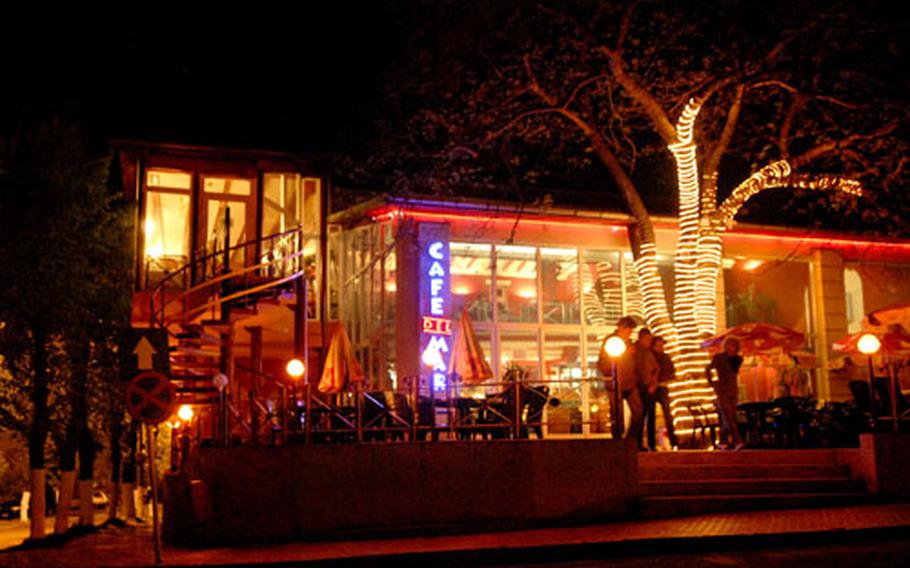
Mangalia’s Café Del Mar, across from the four-star President Hotel, serves up pizza with its disco music. (Ben Bloker / S&S)
Sun-splashed beaches, four-star resorts, Greek colonial ruins and rows of all-night discotheques.
Pothole-ridden roads, nauseating breakfast buffets and busy intersections without traffic lights.
The Spanish Costa del Sol it is not, but Romania’s Black Sea beach towns do offer a chance to catch some relatively inexpensive sun and sea while also exploring the often contradictory subtleties that distinguish this former Eastern bloc state.
Romania’s a country pounding its collective chest after joining its far wealthier western neighbors in the European Union earlier this year while simultaneously struggling to overcome its often justified reputation as a haven for corruption, graft and all-around dodgy behavior.
But as the burgeoning low-cost airline industry eyes this country of 22 million as a hot spot for budget travelers in search of an overseas adventure, the collection of beach towns is sure to be filling up fast.
And you have to pack a strong sense of personal safety and justified skepticism before embarking on a journey to this sunny but still somewhat suspect destination.
But that may just be half the fun.
More than just a strip
On a narrow stretch of land set snugly between the Black Sea and Lake Siutghiol adjacent to the city of Constanta, the resort of Mamaia bills itself as the pearl of the Romanian coast.
In a country where the majority of residents live in utilitarian Soviet-style concrete apartment buildings, the rows of spacious, modern and even Art Deco- inspired hotels stand out like a pearl necklace set against a mountain of coal.
The town has almost no year-round residents, and instead has focused on generating a buzz for tourism — primarily on the international scene as the average Romanian makes roughly $8,800 a year and is more likely to travel abroad for work than to take a domestic seaside vacation. Romania does, however, have an upper class that flocks to the beaches in the warmer months.
Between mid-May and mid-September the town boasts a climate roughly similar to the French Riviera and can accommodate up to 20,000 visitors in 64 hotels.
Most come for the beach, but some migrate in for the nightlife, which is remarkable by Romanian standards.
There are dozens upon dozens of cafes, nightclubs, discotheques and bars, including more than one watering hole where patrons can down the ice-cold local brew Ursus to a thumping techno beat on the cool night sand of the beach.
For those with children in tow, there are also plenty of playgrounds and other little- people-type activities to ensure that boredom is kept at bay.
But be forewarned, the roads that lead from Constanta and other nearby local towns are to be driven with the highest level of caution.
Potholes large enough to swallow a bicycle appear without warning, and some of the city’s busiest intersections are negotiated without the aid of traffic lights. Without the possibility of a red light, it’s every motorist for himself — and that’s nothing to take lightly.
Ruins and rooms
Mangalia is known throughout this region as a resort destination replete with thoroughbred racetracks, high-rise oceanfront hotels and enough sandy beaches for a nation’s worth of sunbathers.
The town is south of Constanta. Between the two, there is a string of beach towns with names inspired by Roman gods — Neptune, Jupiter, Venus and Saturn — that are surely the kind of predictable family getaway a visitor might confuse with Myrtle Beach or Daytona Beach.
But Mangalia is also home to some of Europe’s most interesting historical ruins. Four hundreds years before the birth of Christ, Greek explorers settled colonies in what is now the Mangalia area. The Romans followed and left an impressive infrastructure still visible with very little exploration.
Today, the city’s only four-star accommodation, the Hotel President, is masterfully constructed above and around a swath of Roman-Byzantine ruins roughly the size of a banquet hall.
But a night in the Hotel President is more than just ruins and stunning Black Sea vistas. It also offers the opportunity to stumble across a spirited singing-and- dancing routine from a group of local adolescents, clad in traditional garb, that devolves into a spontaneous Romanian samba line.
And then it’s picking through the Romanian version of a European continental breakfast buffet that leaves one begging for a Black Sea Waffle House.
Pack flexibility
The Romanian Black Sea has far to go in terms of accommodation and reputation to rival Europe’s Mediterranean resorts. But it offers something those locales lost long ago: the sense of the unknown around every corner.
With higher prices and a regular stream of international visitors comes wealth and stability, something the Romanian resorts would surely welcome. But it also brings predictability, and a loss of traditional European sights that make this area intriguing.
Horses still pull carts on state highways in Romania, and children sit alongside parents in roadside stands, hawking vegetables and car parts in equal measure.
And every four-way intersection seems like your first.
Some facts about Romania:
Size: 91,699 square miles, slightly smaller than OregonPopulation: 22 millionMedian age: 36Life expectancy: 72 yearsLanguage: RomanianCapital: BucharestGDP per capita: $8,800Exchange rate: $1 = 2.43 new leiIndustries: Textiles, light machinery, auto assembly, mining and timberBrief history: Former Communist strongman Nicolae Ceausecsu was overthrown and executed in 1989. Former Communists ruled the country until they were swept from power in 1996. Romania joined NATO in 2004 and the European Union in 2007.Source: CIA World Fact book